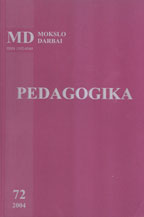Interaktyvaus ugdymo problema muzikos pedagogikoje
The Model of Interactive Education by Art
Author(s): Asta Vaitkevičienė, Gintautas MažeikisSubject(s): Education
Published by: Vytauto Didžiojo Universitetas
Keywords: art; interactive education; model
Summary/Abstract: Relations, oppositions and parallels between L. Vygotsky's educational psychology, H. Gadamer's philosophy of art, M. Bachtin's conception of dialogtsm and modern theories of the interactive aesthetics are considered in the article. The interactive education by means of art plays a significant role in the process of children's socialization and inculturation, formation of fantasies. It stimulates continuous competition and creativity development A piece of art is understood not as a product but as a process, as a flux of impressions, expressions, cognitive decisions, communication, as a language game (in the L. Wittgenstein sense). The interactive education by means of art gives an opportunity for the pupil to experience cognitive decisions, aesthetic pleasure and the necessity of correction of his/her position. Dialogic interpretation of pieces of art helps to continue interactivity processes between children, educator and art object (for example, a picture). Th. Adorno's conception of types of art consumers is considered in the article and this conception is applied for the tasks of interpretation of an art work in the class. The main features of such interpretation are the balance between spontaneous and active expression of emotions and possibilities that relate them with knowledge about common features of art, for example, a picture. The process of giving a name to pieces of art and art viewership are interpreted as free like a game communication. From the first stages of aesthetic experience and consideration of impressions dialogic interactive communication creates possibilities for the development of social attitudes and skills, for the socialization of ego of a pupil and for the beginning of analyses of art pieces. In the process of dialogic interpretation the educator shouldn't disturb expression of emotions of a pupil, and confuse the formulation of rational considerations about a piece of art. In this way the educator preserves unique, subjective relation between a child and the world that is the basis for aesthetic impressions and at the same time this relation guarantees the drama of socialization. However, the art process as a language game, team competition, dialogic interpretation, the flux of conceptual decisions and the whole process of interactive education by art should be strongly adopted to the stages of child development. In this case the authors of this article try to find relations and parallels between postmodern conceptions of interactivity and the traditional constructive school of L. Vygotsky. R. Smith's theory about the stages of aesthetic development of a pupil and adequate separation of tasks for each stage of aesthetic development are discussed in the article.
Journal: Pedagogika
- Issue Year: 2004
- Issue No: 72
- Page Range: 63-71
- Page Count: 9
- Language: Lithuanian

